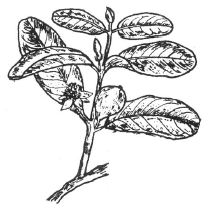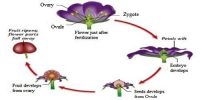Dicot plants bear two cotyledons in their seeds. The root system. is Tap Root System; leaves are with reticulate venation, flowers are Tetramerous or Pentamerous. In the world, the number of the dicotyledonous plant is more. Examples of Dicot plants are Mango, Jamboline (JAAM), Litchi, Jackfruit, Shaal, Teak, Mahogany, Garjan, and Sundari etc. As a representative of Dicot plants, the characteristics and importance of Psidium guava (PEYARA) is described with a.diagram of a small twig of it.
Characteristics:
- Psidium plants are sporophyte. The plant is a small tree with multiple branches.
- Leaves are simple and opposite.
- Flowers are stalked, solitary. It develops from the axis of the leaf.
- The ovary is situated below, the other parts (whorls) of the ‘flower is above the ovary.
- Flowers are bisexual and actinomorphic.

Fig: A portion of Psidium Plant
Importance: The fruits of Psidium are of great importance. The plant is cultivated for its fruits. The ripe fruit is very tasty and the whole of it is edible. Jam, jelly etc. are prepared from its fruit. Leaves are used in the treatment of diarrhoea and dysentery. Water boiled with Psidium leaves is a good curative of gum path.












